“The fifth angel sounded his trumpet, and I saw a star that had fallen from the sky to the earth. The star was given the key to the shaft of the Abyss” (Revelation 9:1 NIV).
The entity described in Revelation 9:1 as the “star that had fallen to earth” is clearly a sentient being capable of thought and interaction. Jesus once identified someone who fell in a similar manner when He told a group of His followers, “…’I saw Satan fall like lightning from heaven'” in Luke 10:18. Thus, we should consider the possibility that these two entities may be one and the same.
This individual received the key to a realm known as “the Abyss,” or “bottomless pit.” The Abyss is associated with the abode of demons, and represents a chasm of immeasurable depth. (1) It also seems to function as a place of confinement for some particularly wicked demons until their release here in the book of Revelation. Thus, it remains securely locked until God elects to release the key.
So this fallen star received access to the Abyss and immediately put that access to use…
“And he opened the bottomless pit, and smoke arose out of the pit like the smoke of a great furnace. So the sun and the air were darkened because of the smoke of the pit.
Then out of the smoke locusts came upon the earth. And to them was given power, as the scorpions of the earth have power. They were commanded not to harm the grass of the earth, or any green thing, or any tree, but only those men who do not have the seal of God on their foreheads. And they were not given authority to kill them, but to torment them for five months.
Their torment was like the torment of a scorpion when it strikes a man. In those days men will seek death and will not find it; they will desire to die, and death will flee from them” (Revelation 9:2-6).
 These verses present us with the imagery of a key that opens the door to malevolent spiritual forces. This should prompt us to consider other doors that should remain closed as we travel the corridor of life. For instance, some of those doors may open the way to an inappropriate relationship, financial devastation, or involvement with various forms of the occult, among others.
These verses present us with the imagery of a key that opens the door to malevolent spiritual forces. This should prompt us to consider other doors that should remain closed as we travel the corridor of life. For instance, some of those doors may open the way to an inappropriate relationship, financial devastation, or involvement with various forms of the occult, among others.
You see, the road to alcoholism, marital infidelity, compulsive gambling, and other harmful behaviors rarely starts with a conscious decision to embrace those activities. Instead, they often begin with an ill-advised decision to open a door that should have remained sealed. If we never open the door to such things, we may avoid the negative consequences that await on the other side.
Image Attribution :silhouette of door knob, via PickPik
(1) G12 – abyssos – Strong’s Greek Lexicon (nasb20). (n.d.). Blue Letter Bible. https://www.blueletterbible.org/lexicon/g12/nasb20/mgnt/0-1/


 In addition to the losses described in the previous verses of Revelation chapter eight, this passage tells us that there will be a thirty-three percent reduction in natural light. Whatever the cause, this will undoubtedly lead to negative changes in the areas of global meteorology, temperature, and agriculture, among others.
In addition to the losses described in the previous verses of Revelation chapter eight, this passage tells us that there will be a thirty-three percent reduction in natural light. Whatever the cause, this will undoubtedly lead to negative changes in the areas of global meteorology, temperature, and agriculture, among others. Verse eleven also adds some additional detail: “The name of the star is Wormwood.” Wormwood is a type of plant that is described by one commentator in the following manner…
Verse eleven also adds some additional detail: “The name of the star is Wormwood.” Wormwood is a type of plant that is described by one commentator in the following manner…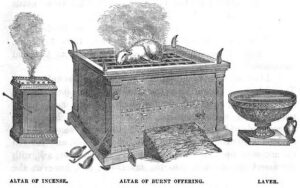 Revelation 8:3 draws upon the imagery of an Old Testament-era priest and the
Revelation 8:3 draws upon the imagery of an Old Testament-era priest and the  As we’re reminded in the New Testament book of 1 Corinthians, “Now we see things imperfectly, like puzzling reflections in a mirror, but then we will see everything with perfect clarity. All that I know now is partial and incomplete, but then I will know everything completely, just as God now knows me completely” (1 Corinthians 13:12 NLT).
As we’re reminded in the New Testament book of 1 Corinthians, “Now we see things imperfectly, like puzzling reflections in a mirror, but then we will see everything with perfect clarity. All that I know now is partial and incomplete, but then I will know everything completely, just as God now knows me completely” (1 Corinthians 13:12 NLT). But now, they stood before His throne. This group raised a poignant question in the previous chapter: “How long, O Lord, holy and true, until You judge and avenge our blood on those who dwell on the earth?” (Revelation 6:10). But now, they held palm branches, a symbol of victory and triumph.
But now, they stood before His throne. This group raised a poignant question in the previous chapter: “How long, O Lord, holy and true, until You judge and avenge our blood on those who dwell on the earth?” (Revelation 6:10). But now, they held palm branches, a symbol of victory and triumph. Revelation 7:1 begins by saying, “After this I saw four angels standing at the four corners of the earth…” This reference to the “four corners of the earth” represents each of the four compass points of the globe. Those angels were responsible for “…holding back the four winds of the earth so no wind could blow on the earth, on the sea, or on any tree” (NET). The “winds” referenced in this passage convey the idea of a violent agitation, a stream of air, or a strong tempestuous wind. (1)
Revelation 7:1 begins by saying, “After this I saw four angels standing at the four corners of the earth…” This reference to the “four corners of the earth” represents each of the four compass points of the globe. Those angels were responsible for “…holding back the four winds of the earth so no wind could blow on the earth, on the sea, or on any tree” (NET). The “winds” referenced in this passage convey the idea of a violent agitation, a stream of air, or a strong tempestuous wind. (1) 18 May, 1980, witnessed the cataclysmic eruption of Mount St. Helens, a volcanic mountain in the western United States. Triggered by an earthquake that registered at 5.1 on the Richter scale, the lateral blast emanating from the mountain’s northern flank ripped through the surrounding landscape at an astonishing speed of 300 miles per hour (483 kph). That eruption produced a 230 square mile (370 square km) periphery of devastation that extended 17 miles (27 km) from the crater. It also produced a vertical eruption of gas and ash that reached 16 miles (26 km) into the atmosphere. 57 people lost their lives in the devastation that followed. (1)
18 May, 1980, witnessed the cataclysmic eruption of Mount St. Helens, a volcanic mountain in the western United States. Triggered by an earthquake that registered at 5.1 on the Richter scale, the lateral blast emanating from the mountain’s northern flank ripped through the surrounding landscape at an astonishing speed of 300 miles per hour (483 kph). That eruption produced a 230 square mile (370 square km) periphery of devastation that extended 17 miles (27 km) from the crater. It also produced a vertical eruption of gas and ash that reached 16 miles (26 km) into the atmosphere. 57 people lost their lives in the devastation that followed. (1)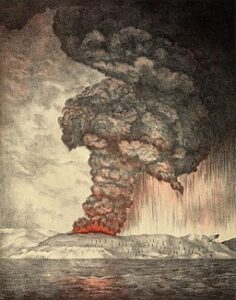 In the late 1800s, the Indonesian island of Krakatoa experienced a volcanic eruption that ranks among history’s most catastrophic natural disasters. Krakatoa’s eruption in August, 1883, generated devastating tsunamis up to 130 feet (40m) high. In its final stages, the noise produced by the exploding volcano was heard thousands of miles away in Australia. The immense power of the volcano’s eruption resulted in the near-total destruction of Krakatoa, along with several nearby islands. It also led to an estimated death toll of more than 36,000 people. (2)
In the late 1800s, the Indonesian island of Krakatoa experienced a volcanic eruption that ranks among history’s most catastrophic natural disasters. Krakatoa’s eruption in August, 1883, generated devastating tsunamis up to 130 feet (40m) high. In its final stages, the noise produced by the exploding volcano was heard thousands of miles away in Australia. The immense power of the volcano’s eruption resulted in the near-total destruction of Krakatoa, along with several nearby islands. It also led to an estimated death toll of more than 36,000 people. (2)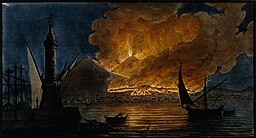 Many centuries earlier, in 79 A.D., the eruption of Mount Vesuvius devastated the ancient Roman cities of Pompeii and Herculaneum in southern Italy. A deluge of volcanic ash and pumice stones engulfed those urban areas, prompting many residents to flee and others to seek shelter. Those who remained in Pompeii were subsequently killed when a cloud of toxic gas engulfed the city. Today, one can tour the architectural ruins of Pompeii and view casts taken of some of those individuals as they faced their final moments of life. (3)
Many centuries earlier, in 79 A.D., the eruption of Mount Vesuvius devastated the ancient Roman cities of Pompeii and Herculaneum in southern Italy. A deluge of volcanic ash and pumice stones engulfed those urban areas, prompting many residents to flee and others to seek shelter. Those who remained in Pompeii were subsequently killed when a cloud of toxic gas engulfed the city. Today, one can tour the architectural ruins of Pompeii and view casts taken of some of those individuals as they faced their final moments of life. (3)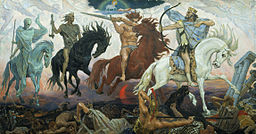 An identical command accompanied the opening of each of the first four seals: “Come and see.” And much like the Apostle John in the book of Revelation, we are also invited to see these emerging horsemen for ourselves. But despite the vivid descriptions of these riders, their identities have been the subject of great debate down through the centuries. We’ll take a closer look at the first horseman of the apocalypse beginning next.
An identical command accompanied the opening of each of the first four seals: “Come and see.” And much like the Apostle John in the book of Revelation, we are also invited to see these emerging horsemen for ourselves. But despite the vivid descriptions of these riders, their identities have been the subject of great debate down through the centuries. We’ll take a closer look at the first horseman of the apocalypse beginning next. In light of those responsibilities, we would do well to consider the way we currently manage the blessings and opportunities God has given us today. For instance, a Christ-oriented life factors the following questions into the decision-making processes of daily living…
In light of those responsibilities, we would do well to consider the way we currently manage the blessings and opportunities God has given us today. For instance, a Christ-oriented life factors the following questions into the decision-making processes of daily living…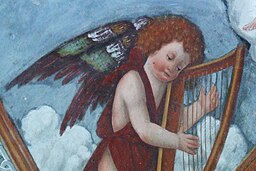 One of the more common illustrations of the heavenly realm features angelic beings who float among the clouds while gently strumming harps. That imagery is likely derived (at least in part) from our text here in Revelation 5:8. Nevertheless, this verse highlights an important element that we might easily overlook: the depiction of the prayers offered by God’s people as golden bowls filled with fragrant incense.
One of the more common illustrations of the heavenly realm features angelic beings who float among the clouds while gently strumming harps. That imagery is likely derived (at least in part) from our text here in Revelation 5:8. Nevertheless, this verse highlights an important element that we might easily overlook: the depiction of the prayers offered by God’s people as golden bowls filled with fragrant incense. This passage then continues with an important detail regarding this scroll, for we are told that it was inscribed on both sides. Although ancient scrolls were typically single-sided, many commentators note that title deeds formed an exception. For instance, the inner portion of a title deed offered a description of the property in question. If a financial hardship led to the sale of that property, the amount owed and repayment terms were written on the outside. Once that information was transcribed, the scroll was refastened with strings and sealed with wax over the knots for security purposes.
This passage then continues with an important detail regarding this scroll, for we are told that it was inscribed on both sides. Although ancient scrolls were typically single-sided, many commentators note that title deeds formed an exception. For instance, the inner portion of a title deed offered a description of the property in question. If a financial hardship led to the sale of that property, the amount owed and repayment terms were written on the outside. Once that information was transcribed, the scroll was refastened with strings and sealed with wax over the knots for security purposes.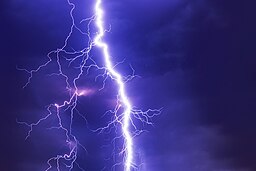 Lightning is among the many wonders of our natural world. A lightning strike with an accompanying peal of thunder may be breathtaking or terrifying, depending on your proximity. Thus, it serves as an excellent representation of God’s immense power. That reference here in Revelation 4:5 is followed by a second appearance of “the seven Spirits” mentioned earlier in
Lightning is among the many wonders of our natural world. A lightning strike with an accompanying peal of thunder may be breathtaking or terrifying, depending on your proximity. Thus, it serves as an excellent representation of God’s immense power. That reference here in Revelation 4:5 is followed by a second appearance of “the seven Spirits” mentioned earlier in  While a royal throne is relatively easy to visualize, it is little more than a highly ornamented armchair if we strip those embellishments away. A throne will not confer special status upon anyone who sits upon it, except perhaps to document his or her experience on social media.
While a royal throne is relatively easy to visualize, it is little more than a highly ornamented armchair if we strip those embellishments away. A throne will not confer special status upon anyone who sits upon it, except perhaps to document his or her experience on social media. passage from Revelation 4:1. Those words are “meta tauta” in the original language of each verse, or “after this.” In other words, the end of Revelation 1:19 corresponds with the beginning of Revelation 4:1.
passage from Revelation 4:1. Those words are “meta tauta” in the original language of each verse, or “after this.” In other words, the end of Revelation 1:19 corresponds with the beginning of Revelation 4:1. Finally, we have this: “…write down… what is going to happen after these things” (GW). This is where the book of Revelation begins to talk about the future, or “…what will be after these things” (NET). With this in mind, we can say that this passage speaks of…
Finally, we have this: “…write down… what is going to happen after these things” (GW). This is where the book of Revelation begins to talk about the future, or “…what will be after these things” (NET). With this in mind, we can say that this passage speaks of… One of the more striking parallels between the first-century church of Laodicea and our twenty-first century world is a mutual sense of apathy or indifference. That common thread of complacency makes Jesus’ message to this church especially relevant for today.
One of the more striking parallels between the first-century church of Laodicea and our twenty-first century world is a mutual sense of apathy or indifference. That common thread of complacency makes Jesus’ message to this church especially relevant for today.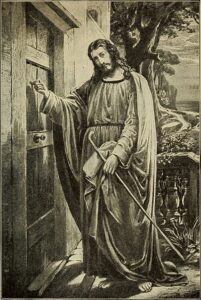 For instance, we might assume that Jesus served as the primary object of worship in the church of Laodicea. But if that was true, then why was He made to wait outside, as implied in the verse quoted above? Furthermore, why did He have to request entry into what was allegedly His church? The most plausible explanation is that this was the church of the Laodiceans, and not Jesus’ church in Laodicea. This likely meant that the church of Laodicea had very little in common with Jesus, except perhaps in name only.
For instance, we might assume that Jesus served as the primary object of worship in the church of Laodicea. But if that was true, then why was He made to wait outside, as implied in the verse quoted above? Furthermore, why did He have to request entry into what was allegedly His church? The most plausible explanation is that this was the church of the Laodiceans, and not Jesus’ church in Laodicea. This likely meant that the church of Laodicea had very little in common with Jesus, except perhaps in name only. On the other hand, an excellent teacher or coach will motivate, instruct, and correct students and athletes in order to enable them to perform at their highest level. Our text from Revelation 3:19 tells us that Jesus does much the same in our spiritual lives. Although it is rarely easy to face correction and discipline, those qualities enable us to secure the growth and development that God seeks for us.
On the other hand, an excellent teacher or coach will motivate, instruct, and correct students and athletes in order to enable them to perform at their highest level. Our text from Revelation 3:19 tells us that Jesus does much the same in our spiritual lives. Although it is rarely easy to face correction and discipline, those qualities enable us to secure the growth and development that God seeks for us.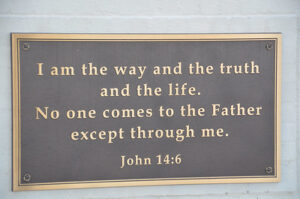 The issue is that God’s Word does not support those views. Those who seek to be accepted by God must approach Him through the mediator He has established. That mediator is Christ, for “...there is one God and one Mediator between God and men, the Man Christ Jesus…” (1 Timothy 2:5). As Jesus Himself once said, “I am the way and the truth and the life. No one comes to the Father except through me” (John 14:6). Much like the church at Laodicea, we are sure to run into similar trouble if our beliefs regarding these essential doctrines fail to align with God’s Word.
The issue is that God’s Word does not support those views. Those who seek to be accepted by God must approach Him through the mediator He has established. That mediator is Christ, for “...there is one God and one Mediator between God and men, the Man Christ Jesus…” (1 Timothy 2:5). As Jesus Himself once said, “I am the way and the truth and the life. No one comes to the Father except through me” (John 14:6). Much like the church at Laodicea, we are sure to run into similar trouble if our beliefs regarding these essential doctrines fail to align with God’s Word. So the Laodicean church attempted to take a noncommittal, “middle of the road” approach in their relationship with Christ. Of course, the issue facing anyone who stays to the middle of the road is that he or she is always in danger of being run over. In this instance, the Laodiceans’ apathy towards Jesus led Him to respond in the following manner…
So the Laodicean church attempted to take a noncommittal, “middle of the road” approach in their relationship with Christ. Of course, the issue facing anyone who stays to the middle of the road is that he or she is always in danger of being run over. In this instance, the Laodiceans’ apathy towards Jesus led Him to respond in the following manner… In this context, “cold” refers to a state of indifference or insensitivity. The word “hot” conveys a sense of excitement, intensity, or enthusiasm. So it appears that the Christians in Laodicea weren’t dismissive of Jesus, but they weren’t zealous for Him either. They acknowledged Christ, but their devotion to Him was tepid and detached. Their profession of Christianity was the type that had little impact on their attitudes or conduct beyond the confines of their church.
In this context, “cold” refers to a state of indifference or insensitivity. The word “hot” conveys a sense of excitement, intensity, or enthusiasm. So it appears that the Christians in Laodicea weren’t dismissive of Jesus, but they weren’t zealous for Him either. They acknowledged Christ, but their devotion to Him was tepid and detached. Their profession of Christianity was the type that had little impact on their attitudes or conduct beyond the confines of their church.